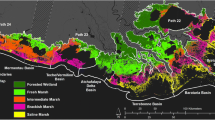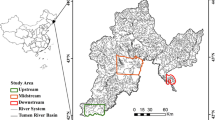Abstract
High productivity and accessibility have made coastal wetlands attractive sites for human settlements. This study analyzed the patterns of wetland landscapes in Galveston Bay, Texas, USA. The first objective of the study was to describe the relationships between the fractal dimension of wetland boundaries and those factors which affect the wetland landscapes (e.g., land use, type of vegetation, size, location, and level of human disturbance). The second objective was to construct a historical database to contrast wetland areas which had experienced different levels of disturbance between 1956 and 1989. The fractal dimension, a measure of how much of the geographical space is filled by boundaries, was measured by the perimeter-area method. The fractal dimension of wetlands was significantly affected by land use, type of vegetation, size, and level of anthropogenic disturbance. In addition, increasing the size of buffers around roads did not significantly affect the fractal dimension of wetlands. Landscape indices, such as fractal dimension, dominance, and diversity, were used to characterize spatial heterogeneity in the historical database. Lake Stephenson, an area of low anthropogenic disturbance, experienced no changes in wetland composition and abundance over time. Anahuac, an area of medium disturbance, experienced changes in both wetland composition and abundance. Texas City, an area of high disturbance, experienced a change in wetland composition. These differences can be associated with the type and level of disturbance present; however, more evidence is needed to determine whether certain landscape patterns have stable, intrinsic properties which allow persistence in the face of disturbance. These results will be informative to resource managers determining how wetlands can be managed as natural resources and nature reserves.
Similar content being viewed by others
References
Anderson, J. R., Hardy, E. E., Roach, J. T. and Witman, R. E. 1976. A land use and land cover classification system for use with remote sensor data. U.S. Geol. Surv. Prof. Paper 964.
Andrews, A. 1990. Fragmentation of habitat by roads and utility corridors: a review. Austral. Zool. 26: 130-141.
Benton, A. R., Snell, W. and Clark, C. A. 1979. Monitoring and mapping of Texas coastal wetlands: Galveston Bay and Sabine areas. Technical Report RSC-102.
Browder, J. A., May, L. N., Rosenthal, A. and Gosselink, J. G. 1989. Modeling future trends in wetland loss and brown shrimp production in Louisiana using thematic mapper imagery. Remote Sensing Environ. 56: 871–886.
Bruce, K. A., Cameron, G. N., Harcombe, P. A., Jubinsky, G. 1997. Introduction, Impact on Native Habitats, and Management of a Woody Invader, the Chinese Tallow Tree, Sapium sebiferum. Nat. Areas J. 13: 255–260.
Cowardin, L. M., Carter, V., Golet, F. C. and LaRoe, E. T. 1979. Classification of Wetlands and Deepwater Habitats of the United States. U.S. Fish & Wildlife Service Pub. FWS/OBS-79/31, Washington, D.C., USA.
Craig, N. J., Turner, R. E. and Day Jr., J. W. 1979. Land loss in coastal Louisiana (U.S.A.). Environ. Manag. 3: 133–144.
Dahl, T. E. 1990. Wetland Losses in the United States, 1780s to 1980s. U.S. Department of the Interior, Fish and Wildlife Service, Washington, D. C., USA.
Dahl, T. E., and Johnson, C. E. 1991. Wetland Status and Trends in the Conterminous United States Mid-1970s to mid-1980s. U.S. Department of Interior, Fish and Wildlife Service, Washington, D.C., USA.
Fahrig, L., Pedlar, J. H., Pope, S. E., Taylor, P. D. and Wegner, J. F. 1995. Effect of road traffic on amphibian density. Biol. Cons. 72: 1–6.
Falconer, K. 1990. Fractal Geometry — Mathematical Foundations and Applications. John Wiley and Sons, New York, NY, USA.
Findlay, C. S. and Houlahan, J. 1997. Anthropogenic correlates of species richness in southern Ontario wetlands. Cons. Biol. 11: 1000–1009.
Forman, R. T. T., and Godron, M. 1986. Landscape Ecology, John Wiley & Sons, New York, NY, USA.
Frayer, W. E., Monahan, T. J., Bowden, D. C. and Graybill, F. A. 1983. Status and Trends of Wetlands and Deepwater Habitat in the Conterminous United States, 1950s to 1970s. Dept. of Forest and Wood Sciences, Colorado State University, Fort Collins, CO, USA.
Gagliano, S. M. 1973. Canals, dredging, and land reclamation in the Lousiana coastal zone. Hydrologic and Geologic Studies of Coastal Lousiana, Rept. No. 14. Coastal Resources Unit. Center for Wetland Resources, Lousiana State University, Baton, Rouge, LA, USA.
Gagliano, S. M., Meyer-Arendt, K. J. and Wicker, K.M. 1981. Land loss in the Mississippi River deltaic plain. Trans. Gulf Coast Assoc. Geol. Soc. 31: 295–300.
Gibbs, J. P. 1993. Importance of small wetlands for the persistence of local populations of wetland-associated animals. Wetlands 13: 25–31.
Henderson, M. T., Merriam, G. and Wegner, J. 1985. Patchy environments and species survival: chipmunks in an agricultural mosaic. Biol. Cons. 31: 95–105.
Holland, M. M, Risser, P. G. and Naiman, R. J. 1991. Ecotones: The Role of Landscape Boundaries in the Management and Restoration of Changing Environment. Chapman & Hall, New York, NY, USA.
Johnston, C. A. 1991. Sediment and nutrient retention by freshwater wetlands: effects on surface water quality. Crit. Rev. Environ. Control 21: 491–565.
Kent, C. and Wong, J. 1982. An index of littoral zone complexity and its measurement. Can. J. Fish. Aquat. Sci. 39: 847–853.
Krummel, J. R., Gardner, R. H., Sugihara, G., O'Neill, R. V. and Coleman, P. R. 1987. Landscape patterns in a disturbed environment. Oikos 48: 321–324.
Lam, N. S. N. and Quattrochi, D. A. 1992. On the issues of scale, resolution, and fractal analysis in the mapping sciences. Prof. Geograph. 44: 88–98.
Lonsdale, W. M. and Lane, A. M. 1994. Tourist vehicles as vectors of weed seeds in Kakadu National Park, North Australia. Biol. Cons. 69: 277–283.
Mandelbrot, B. B. 1977. Fractals: Form, Chance, and Dimension. Freeman, San Francisco, CA, USA.
McGarigal, K., and Marks, B. J. 1995. FRAGSTATS: Spatial Pattern Analysis Program for Quantifying Landscape Structure. Gen. Tech. Report PNW-GTR-351. USDA Forest Service, Pacific Northwest Research Station, Portland, OR, USA.
McLeese, R. L., and Whiteside, E. P. 1977. Ecological effects of highway construction upon Michigan woodlots soil relationships. J. Environ. Qual., 6: 467–471.
Meltzer, M. I., and Hastings, H. M. 1992. The use of fractals to assess the ecological impact of increased cattle production: case study from the Runde Communal Land, Zimbabwe. J. Appl. Ecol. 29: 635–646.
Merriam, G., Kozakiewicz, M., Tsuchiyia, E. and Hawley, K. 1989. Barriers as boundaries for metapopulations and demes of Peromyscus leucopus in farm landscapes. Landsc. Ecol. 2: 227–235.
Millar, J. B. 1971. Shoreline-area ratio as a factor in rate of water loss from small sloughs. J. Hydrol. 14: 259–284.
Milne, B. T. 1991. The utility of fractal geometry in landscape design. Landsc. Urban Planning 21: 81–90.
Milne, B. T. 1992. Spatial aggregation and neutral models in fractal landscapes. Am. Nat. 139: 32–57.
Minello, T. J., Zimmerman, R. J. and Medina, R. 1994. The importance of edge for natant macrofauna in a created salt marsh. Wetlands 14: 184–198.
Mitsch, W. J. and Gosselink, J. G. 1993. Wetlands, Van Nostrand Reinhold, New York, NY, USA.
Moulton, D. W., Dahl, T. E. and Dall, D. M. 1997. Texas Coastal Wetlands: Status and Trends, Mid-1950s to Early 1990s. U.S. Department of Interior, Fish and Wildlife Service, Southwestern Region, Albuquerque, NM, USA.
O'Neill, R. V., Krummel, J. R., Gardner, R. H., Sugihara, G., Jackson, B., DeAngelis, D. L., Milne, B. T., Turner, M. G., Zygmunt, B., Christiensen, S. W., Dale, V. H. and Graham, R. L. 1988. Indices of landscape pattern. Landsc. Ecol. 1: 153–162.
Peterjohn, W. T. and Correll, D. L. 1984. Nutrient dynamics in an agricultural watershed: observation on the role of a riparian forest. Ecology 65: 1466–1475.
Peterson, G. W. and Turner, R. E. 1994. The value of salt marsh edge vs. interior as a habitat for fish and decapod crustaceans in a Louisiana tidal marsh. Estuaries 17: 235–262.
Pinay, G., and Decamps, H. 1988. The role of riparian woods in regulating nitrogen fluxes between the alluvial aquifer and surface water: a conceptual model. Regul. Rivers Res. Manag. 2: 507–516.
Rex, K.D. and Malanson G.P. 1990. The fractal shape of riparian forests. Landsc. Ecol. 4: 249–258.
SAS. 1982. User's Guide: Statistics. Statistical Analysis Systems, Cary, NC, USA.
Shaw, S.P. and Fredine, C. G. 1956. Wetlands of the United States, Their Extent, and Their Value for Waterfowl and Other Wildlife. U.S. Department of Interior, Fish and Wildlife Service, Circular 39, Washington, D.C., USA.
Shipley, F. S. and Kiesling, R. W. (eds). 1994. The State of the Bay: A Characterization of the Galveston Bay Ecosystem. Publication GBNEP-44. The Galveston Bay National Estuary Program Galveston, TX, USA.
Snedecor, G.W. and Cochran, W. G. 1980. Statistical Methods. The Iowa State University Press, Ames. pp. 384-389.
Soule, M. E., Alberts, A. C. and Bolger, D. T. 1992. The effects of habitat fragmentation on chapparal plants and vertebrates. Oikos 63: 39–47.
Sugihara, G., and May, R. M. 1990. Applications of fractals in ecology. Trends Ecol. Evol. 5: 79–86.
Turner, M. G. (ed). 1987. Landscape Heterogeneity and Disturbance. Springer-Verlag, New York, NY, USA.
Turner, M. G. 1989. Landscape ecology: the effects of pattern on process. In Annual Review of Ecology and Systematics. pp. 171–198. Edited by R. F. Johnston, P. W. Frank and C. D. Michener. Annual Reviews, Inc., Palo Alto, CA, USA.
Wiens, J. A. 1992. Ecological flows across landscape boundaries: a conceptual overview. In Landscape Boundaries: Consequences for Biotic Diversity and Ecological Flows. Ecological Studies 92. pp. 217-235. Edited by A. J. Hansen and F. Di Castri. Springer-Verlag, New York, NY, USA.
White, W. A., Tremblay, T. A., Wermund, Jr., E. G. and Handley, L. R. 1993. Trends and Status of Wetland and Aquatic Habitats in the Galveston Bay System, Texas. Publication GBNEP-31. The Galveston Bay National Estuary Program, Galveston, TX, USA.
Young, K. R. 1994. Roads and the environmental degradation of tropical montane forests. Cons. Biol. 8: 972–976.
Author information
Authors and Affiliations
Rights and permissions
About this article
Cite this article
Liu, A.J., Cameron, G.N. Analysis of landscape patterns in coastal wetlands of Galveston Bay, Texas (USA). Landscape Ecology 16, 581–595 (2001). https://doi.org/10.1023/A:1013139525277
Issue Date:
DOI: https://doi.org/10.1023/A:1013139525277




